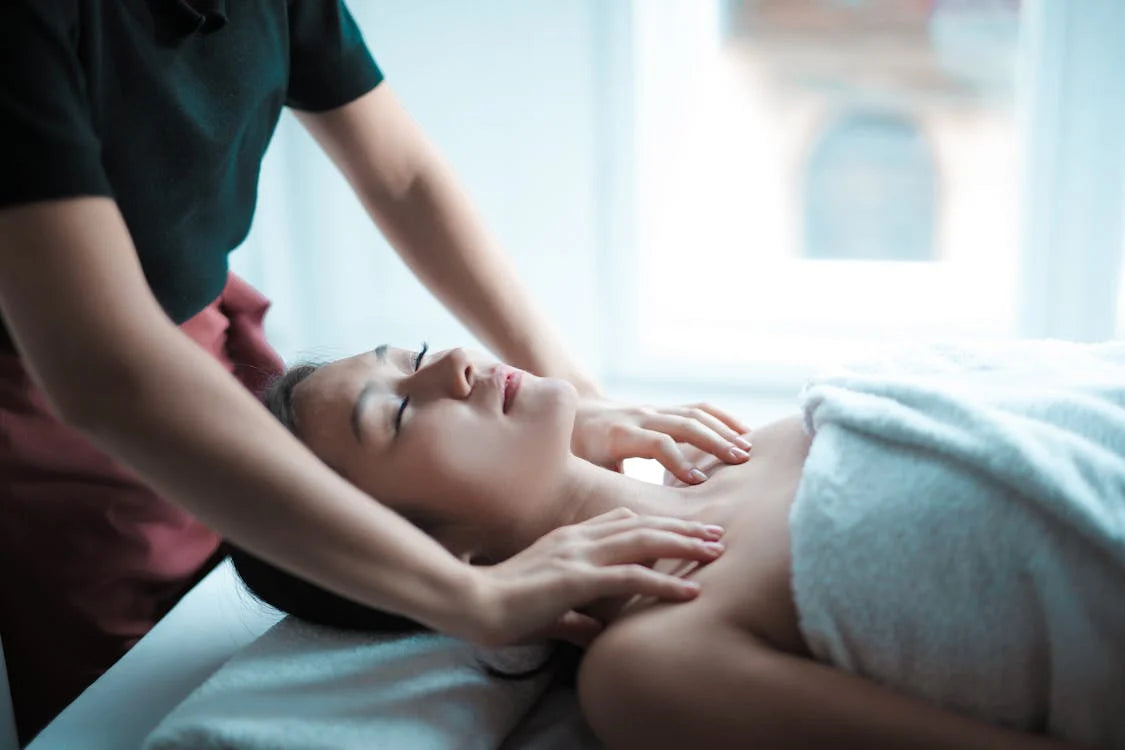
How To Ace Your CMTO OSCE Exam: Treatment Station
In this station, you’ll need to conduct a focused treatment based on the information randomly selected in the stem. Unless stated otherwise, informed consent is not required for this station. I cant stress t this enough READ the stem thoroughly and don’t over think it. Everything you need to know is on the stem, the rest is literally in your hands.
Massage Techniques
-
Effleurage
- Use: Warm-up, relaxation, and assessment of tissues.
- Effects: Increases blood circulation, warms tissues, and provides a soothing effect.
- Contraindications: Open wounds, acute inflammation, and severe varicose veins.
- How to Perform: Use long, gliding strokes with the palms of the hands.
-
Petrissage
-
Muscle Squeezing
- Use: Breaks down adhesions, increases circulation.
- Effects: Reduces muscle tension, improves blood and lymph flow.
- Contraindications: Acute muscle tears, severe varicosities.
- How to Perform: Lift and squeeze the muscle tissue with a kneading motion.
-
Stripping
- Use: Treats tight muscles and trigger points.
- Effects: Lengthens muscle fibers, releases adhesions.
- Contraindications: Acute injuries, inflammation.
- How to Perform: Apply deep pressure along the muscle fibers.
-
Wringing
- Use: Reduces tension and improves mobility.
- Effects: Increases circulation and flexibility.
- Contraindications: Fragile skin, acute injuries.
- How to Perform: Twist the muscle tissue as if wringing out a towel.
-
Kneading
- Use: Softens tissues, reduces tension.
- Effects: Enhances blood flow, promotes relaxation.
- Contraindications: Acute injuries, severe edema.
- How to Perform: Use circular motions to knead the muscle.
-
Muscle Squeezing
-
Ischemic Compressions
- Use: Deactivate trigger points.
- Effects: Reduces pain and muscle spasms.
- Contraindications: Acute injuries, infection, fragile blood vessels.
- How to Perform: Apply sustained pressure directly to the trigger point.
-
Fascial Work
- Use: Release fascial restrictions.
- Effects: Improves mobility and reduces pain.
- Contraindications: Acute inflammation, recent fractures.
- How to Perform: Use slow, sustained pressure to stretch the fascia.
-
Trigger Point Release
- Use: Deactivate trigger points.
- Effects: Reduces pain and improves function.
- Contraindications: Acute injuries, infection.
- How to Perform: Apply pressure to the trigger point until it releases.
-
Stroking
- Use: Relaxation, sensory feedback.
- Effects: Soothes the nervous system, promotes relaxation.
- Contraindications: Open wounds, severe varicosities.
- How to Perform: Use light, gentle strokes over the skin.
-
Friction
- Use: Breaks down adhesions and scar tissue.
- Effects: Increases mobility and reduces pain.
- Contraindications: Acute inflammation, fragile skin.
- How to Perform: Apply deep, circular or transverse pressure to the tissue.
-
Vibrations
-
Fine Vibrations
- Use: Relaxation, pain relief.
- Effects: Soothes the nervous system.
- Contraindications: Acute injuries, severe pain.
- How to Perform: Apply gentle, rapid oscillations with fingers.
-
Coarse Vibrations
- Use: Stimulates tissues, relieves pain.
- Effects: Increases blood flow, reduces muscle tension.
- Contraindications: Acute inflammation, fragile blood vessels.
- How to Perform: Apply stronger, more pronounced oscillations.
-
Static Vibrations
- Use: Pain relief, relaxation.
- Effects: Soothes the nervous system.
- Contraindications: Acute injuries, severe pain.
- How to Perform: Hold the vibration in one spot.
-
Running Vibrations
- Use: General relaxation.
- Effects: Soothes the nervous system, reduces tension.
- Contraindications: Acute injuries, severe pain.
- How to Perform: Move the vibrating hand along the muscle.
-
Fine Vibrations
-
Tapotement
-
Tapping
- Use: Stimulates tissues, promotes circulation.
- Effects: Invigorates the body, increases blood flow.
- Contraindications: Bony areas, acute inflammation.
- How to Perform: Lightly tap with the fingertips.
-
Hacking
- Use: Stimulates tissues, improves muscle tone.
- Effects: Invigorates the body, increases blood flow.
- Contraindications: Bony areas, acute inflammation.
- How to Perform: Use the ulnar border of the hands in a chopping motion.
-
Cupping
- Use: Stimulates tissues, clears congestion.
- Effects: Increases blood flow, releases mucus in respiratory conditions.
- Contraindications: Over the spine, acute inflammation.
- How to Perform: Form a cup shape with your hands and perform a rhythmic, clapping motion.
-
Beating
- Use: Deep muscle stimulation.
- Effects: Increases blood flow, reduces muscle tension.
- Contraindications: Over the spine, acute inflammation.
- How to Perform: Use a fist in a pounding motion.
-
Tapping
-
Rocking
- Use: General relaxation.
- Effects: Soothes the nervous system, promotes relaxation.
- Contraindications: Nausea, vertigo.
- How to Perform: Gently rock the client's body or limbs.
-
Shaking
- Use: Reduces muscle tension.
- Effects: Promotes relaxation and increases mobility.
- Contraindications: Acute injuries, severe pain.
- How to Perform: Shake the muscle group or limb gently.
-
Passive Stretching
- Use: Increases flexibility and range of motion.
- Effects: Lengthens muscles, reduces tension.
- Contraindications: Acute injuries, hypermobility.
- How to Perform: Move the client's limb into a stretch without their assistance.
-
Joint Play
- Use: Improves joint mobility.
- Effects: Increases range of motion and reduces pain.
- Contraindications: Joint instability, acute inflammation.
- How to Perform: Apply gentle, oscillatory movements to the joint.
-
Muscle Approximation
- Use: Reduces muscle spasms.
- Effects: Shortens the muscle, promoting relaxation.
- Contraindications: Acute injuries, hypermobility.
- How to Perform: Bring the muscle attachments closer together.
-
Manual Lymphatic Drainage
- Use: Reduces swelling and promotes lymph flow.
- Effects: Decreases edema, enhances immune function.
- Contraindications: Acute infections, congestive heart failure.
- How to Perform: Use light, rhythmic strokes towards the lymph nodes.
-
PNF (Proprioceptive Neuromuscular Facilitation)
-
Hold Relax
- Use: Increases flexibility.
- Effects: Relaxes and lengthens muscles.
- Contraindications: Acute injuries, severe pain.
- How to Perform: Hold the muscle in a stretched position, then have the client contract against resistance.
-
Contract Relax
- Use: Improves range of motion.
- Effects: Enhances flexibility and muscle relaxation.
- Contraindications: Acute injuries, severe pain.
- How to Perform: Stretch the muscle, then have the client contract and relax it.
-
CRAC (Contract Relax Antagonist Contract)
- Use: Further increases range of motion.
- Effects: Maximizes flexibility.
- Contraindications: Acute injuries, severe pain.
- How to Perform: Stretch the muscle, contract it, then have the client contract the opposing muscle.
-
Hold Relax
Principles of Massage
-
Superficial, Deep, Superficial
- Explanation: Start with light strokes to warm up the tissues, proceed to deeper techniques for therapeutic effects, and finish with light strokes to soothe and relax.
- How to Perform: Begin with effleurage, move to deeper petrissage or friction, and end with effleurage or gentle stroking.
-
General, Specific, General
- Explanation: Begin with broad, general strokes to assess and warm up the area, focus on specific areas needing treatment, and finish with general strokes to integrate the treatment.
- How to Perform: Start with effleurage over the entire back, focus on specific knots with ischemic compression, and end with general effleurage.
-
Proximal, Distal, Proximal
- Explanation: Start the massage closer to the heart to promote circulation, move towards the extremities, and finish near the heart.
- How to Perform: Begin with effleurage on the upper thigh, move down to the calf, and end back at the thigh.
-
Peripheral, Central, Peripheral
- Explanation: Begin with strokes on the periphery of the problem area, move to the central part of the issue, and finish with strokes on the periphery again.
- How to Perform: Start with effleurage around the edges of a sore shoulder, work on the central trigger points, and end with effleurage around the shoulder again.
Practice Case Example
Stem: Client presents with shoulder pain and restricted range of motion.
Steps:
-
Effleurage to warm up the shoulder area.
- "I’ll start with some gentle strokes to warm up the muscles."
-
Petrissage (kneading and muscle squeezing) on the deltoid and upper trapezius.
- "Next, I’ll apply deeper pressure to release muscle tension."
-
Ischemic Compressions on identified trigger points in the shoulder.
- "I’ll apply sustained pressure to these tight spots to help release them."
-
Passive Stretching of the shoulder.
- "I’ll gently move your arm to stretch the shoulder muscles."
-
Trigger Point Release on the infraspinatus and teres minor.
- "I’ll use pressure to release specific tight areas in the shoulder."
-
Finish with Effleurage to soothe the treated area.
- "Finally, I’ll use light strokes to calm the muscles and improve circulation."
